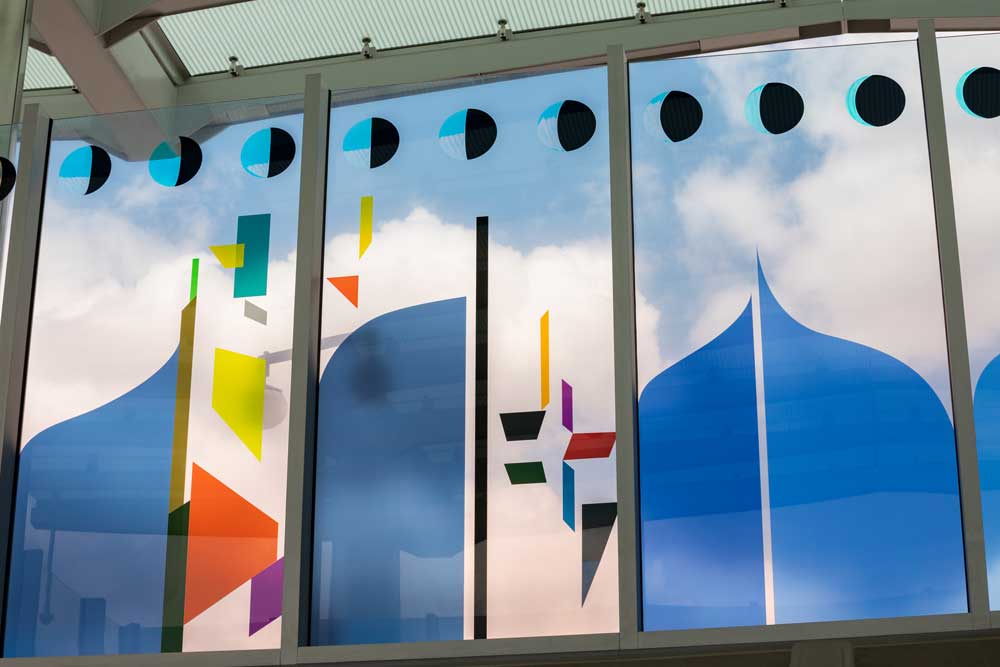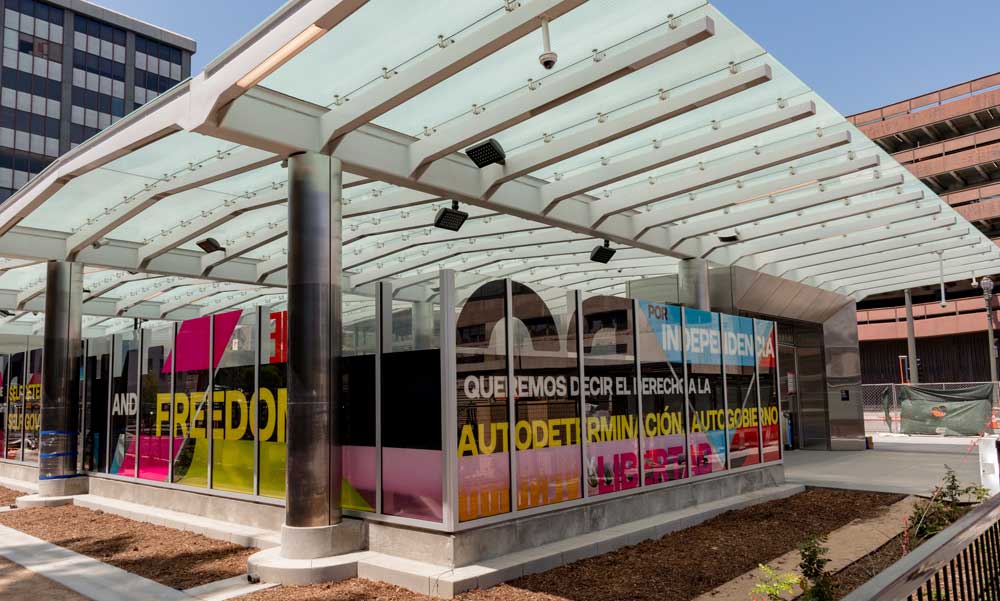Visiting the three new Downtown LA Metro stations recently, I found myself intrigued with how artists commissioned by Metro Art use the transparency of glass to design artworks. The street level of the stations is enclosed by glass, both to allow natural light in and to show people outside what is inside, and vice versa. It creates a certain built-in welcome to pedestrians, both those planning to hop aboard a train as well as those who haven’t yet.

Clare Rojas’s, Harmony, Little Tokyo/Arts District Station – A/E Line.
The new Little Tokyo/Arts District Station is a wonderful example of transforming something functional into something beautiful, even joyful. The glass panels enclosing the entry deck bear a whimsical design by Clare Rojas. The Bay-area artist is known for her colorful, graphic style, often in a story-telling vein but also in more abstract patterns, as at this station. Here she paired tall curved, sail-like shapes with rectangular blocks that suggest skyscrapers; along the top runs a series of circles which look like the waxing and waning of the moon. The work is called Harmony; a gentle reminder of how we live in the city, but also in time—a time counted out by heavenly spheres.
Meanwhile, at the next station, Historic Broadway, the noted LA artist Andrea Bowers uses letters in different sizes and colors to spell out two phrases, which appear both in English and Spanish. These are two phrases often heard in public rallies in the ’60s, “The people united will never be divided” (El pueblo unido jamás será vencido) and “By independence we mean the right to self-determination, self-government and freedom.” Bowers has said about this work, “I seek to reflect the diverse communities that regularly gather downtown to express their voices and their rights.”
The phrases run across several panels and are divided by brackets, so a passerby might randomly pick up a word or two like “freedom” or “libertad.” They would have to pause to read the whole phrase, which is what an artist hopes for, right?—a moment of concentrated attention and, hopefully, reflection on what the work might mean.

Ann Hamilton’s, under-over-under, at Grand Av Arts/Bunker Hill Station.
Ann Hamilton is a well-known conceptual and performance artist based in Columbus, Ohio, and her appetite for public art was whetted when she did a mosaic for a subway station in New York City. After learning about the Metro Art program, and submitting her qualifications for consideration for public art opportunities in the LA transit system, she was selected for a commission at the new Grand Avenue Arts/Bunker Hill Station, specifically for the elevator banks. Six elevators go from the lower level to the street level of the station, which is sandwiched between a view of DTLA buildings and a plaza with The Broad museum and Otium restaurant—nearby is MOCA, as well as Disney Hall and the Music Center complex.
“For me the challenge was can we take something like vinyl and give it the fineness of something hand-drawn,” Hamilton said during a phone interview. Her project, under-over-under, put together ideas of urban intersections with weaving, and she began to draw by hand parallel lines that were like threads of cloth; she reminded me that in her early days she worked with textiles. The drawn lines were translated onto blue vinyl overlays, which were applied to the glass walls of the elevators and of the exteriors. “As the shaft of the elevator travels up and down, you’re literally weaving the pattern,” she added.
I mentioned that I felt a certain calming sensation as the lines crossed—maybe it was the lull of being in motion, maybe it was the blue. “That was partly was my intention,” Hamilton admitted. “How does it wrap you, you’re now inside the cloth. It’s like the feeling of that as much as the image.”
Many more infrastructure projects are on the horizon. To learn more about opportunities with Metro Art, visit metro.net/art and click on Art Opportunities.


